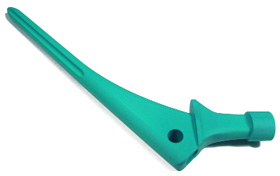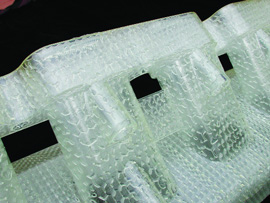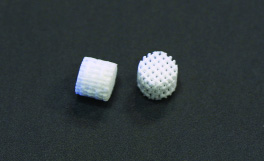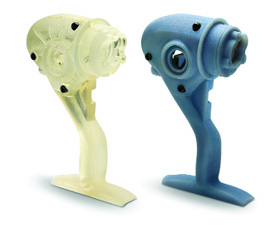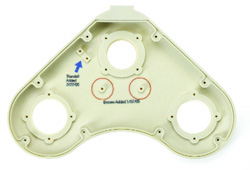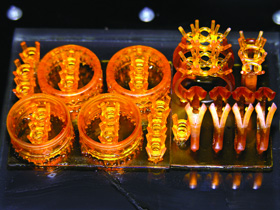Latest News
April 1, 2005
By Pamela J. Waterman
An engineering design consultant involved in numerous mechanicalprojects recently said he groans whenever a client asks for a rapidprototype. The reason: inevitably, the parts lack the material strengthneeded for their designed purpose.That assessment begs an investigation to determinewhether it'saccurate or just a holdover opinion going back to the old days of rapidprotoyping (RP). Because of the nature of the technology, the materialshave changed over the last 15, 10, or even two years, so the time isripe for an update. We'll look at both additive manufacturing systemsas well as subtractive alternatives (i.e., machining), plus a fewhybrid technologies.
This prototype hip-stem was created using Solidscape's newInduraCast material on a T612 Benchtop system. It is 200 percentstronger than BlueCast, doesn't shrink or leave any residue, and can beformed at room temperature.
Supplies from the System Houses
3D Systems offers three families of materials, with resins appropriatefor various stereo-lithography apparatus (SLA), selective lasersintering (SLS), or multijet modeling (MJM) systems. New for SLA usersis the introduction of materials that can withstand highertemperatures: Accura Bluestone for Viper and 5000/7000 systems, andAccura si 45HC for originally configured 250s.
“Most of the time,” says Steve Hanna,3D Systems product manager for SLMaterials, “when you are trying to get higher thermal resistancein a product, you tend to sacrifice durability. Bluestone is verydifferent from traditional RP materials. It's a ceramicnanocomposite—part plastic, part ceramic—that was developed for veryhigh stiffness, yet it can operate up to 250°C.” Accura si supportsfaster build times, works above 100°C, and is able to do some snap-fitand functional assembly work. A third Accura material, si 50 in naturaland gray, simulates ABS plastic with high accuracy for thin-walledparts and functional snap-fit assemblies.
|
| |
This automotive manifold was created with Somos 11120. It is idealfor investment casting due to low moisture absorption, which means moreaccuracy during production. It also mimics many ABS properties and canbe finished clear or frosted white. | Therics has a new composite ceramic/biodegradable polymer moredurable than its first-generation resorbable bone-scaffolding. Itallows surgeons to shape grafts as they work with them, it doesnot require heat treatment, and can be combined with activebiological elements such as enzymes and growth factors. |
EnvisionTec has introduced four new resins over the past year for itsPerfactory digital light processing (DLP) equipment: a brownish-yellowpolypropylene-like material (50-125 micron layers) useful for livinghinges and can be drilled; black R5 (50-150 microns) and red R11 (15-50microns) suitable for conceptual as well as high-detail models,especially for silicon molding; yellow PIC100 (paraffin investmentcasting) material for direct investment casts of jewelry; and askin-tone biocompatible (Class 6) material for medical devices andhearing-aid shells (50-100 microns).
These fishing reels have been produced in original transparentresin and high-strength VeroBlue acrylic photopolymer, developed byObjet Geometries for the Stratasys Eden machines. VeroBluehas higherflexural modulus and more impact strength.
The EOSINT family of direct metal laser sintering (DMLS) machines fromEOS uses a variety of powdered plastic and metal materials in itslaser-sintering systems. New last year was PrimePart, a polyamide-basedmaterial that, according to the company, produces thinner layers andmore detailed resolution than previously available. Other materials inthe works include a fire-retardant plastic, different stainless steels,and alloys of cobalt-chrome,titanium, and Inconel (austenitic nickel-chromium-ironalloy).
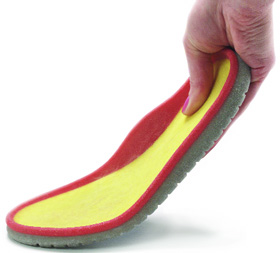
This image shows the flexibility that can be achieved with Z Corp'selastomer material. Parts are infiltrated with an elastomer(Port-a-Mold) to give them rubber-like properties for a wide range ofapplications.
Extrude Hone has improved the properties of its bronze-infiltratedstainless-steel parts by virtue of improving the operation of its 3DPR2 machine. According to Howard Kuhn, Extrude Hone's Director ofRandD, the redesign allows the same powders to produce parts with amore uniform infiltration for a more uniform hardness with less than 1percent porosity. They have also tackled the challenge of minimizingshrinkage and distortion, achieving homogeneous 420 stainless steel bysintering it to full density without bronze infiltration.
Objet Geometries continues to develop materials for its Eden family ofmachines, distributed by Stratasys in the US. Its transparent FullCure720 has been joined by FullCure 830 Vero Blue, an opaque material witha higher flexural modulus and higher impact strength; the color alsoshows better detail. FullCure 840 VeroWhite, currently in finaltesting, will have higher humidity resistance and will work with theEden 260/330/333 systems. FullCure Tango, a material with elasticproperties, is in beta testing.
Roland DGA Corporation's Advanced Solutions Division looks at RP fromthe subtractive viewpoint, offering fast machining on a wide variety oftraditional materials that provide true engineering properties. ABS,delrin, nylon, styrenfoam, aluminum 5052, and machineable clay are justsome of the materials available to designers and engineers for creatingfunctional prototypes on the Roland MDX series.
This prototype demonstrates the thin walls and high resolutioncolor labeling achievable with Z Corp's High Performance Composite. Itcan be used to make strong, high-definition color using a heavilyengineered plaster material.
Solidica continues to focus on aluminum for its ultrasonicconsolidation (UC) Formation machine, combining the dimensional andsurface accuracy of machining with the speed of an additive RP process.Ken Johnson, Solidica's vice president of strategic development andmarketing notes, however, that they are doing developmental workbonding copper and silver to gain the benefits of both a heat-sink andelectrical conductivity. Work is also under way with stainless steeland titanium.
Solidscape recently introduced three new materials for use with its T6xBenchtop line: InduraCast for modeling, InduraFill for support, andInduraBase for a reusable build-base. The company states thatInduraCast provides 200 percent more strength than its BlueCastmaterial, does not shrink, and leaves no residue so that it functionswell for investment casting. They also improved processing speed bythree times because it is formed at room temperature (no coolingrequired). Low-cost InduraBase sheets can be reused approximately 100times, and are much easier to handle than the previous generation ofbases.
These jewelry parts were built on the Envisiontec PerfactoryMultilens MINI System using PIC100 (paraffin investment castable)material.
Soligen Technologies continues to offer a manufacturing service calledParts Now, using its direct shell production casting (DSPC) method toproduce intricate cast parts. Using DSPC allows production of parts inaluminum, magnesium, iron, zinc, superalloy steels, titanium, andstainless steels.
| Material Properties: A Primer
Material properties are mathematically and physically definedattributes useful for evaluating and comparing materials, some of whichare based on ASTM standards. Here are terms commonly used onmanufacturer spec sheets: machinist-materials.com/hardness.htm |
Stratasys now markets the VeroBlue acrylic photopolymer developed byits partner Objet Geometries for use on Eden 333 polyjet machines. TheVeroWhite material release is imminent, and the resin series withrubber-like elasticity will soon follow. For its fused depositionmodeling (FDM) line of equipment, Stratasys has previewed a blackPC-ABS blend, and also markets a new medical-grade polycarbonate calledPC-ISO, available in translucent and white; the latter can besterilized and features high impact and flexural strength.
Therics continues to use 3D printing (3DP) to create implantablemedical products. This past year the company focused on developing acomposite ceramic/biodegradable polymer material more durable than itsfirst-generation resorbable bone-scaffolding. The composite also allowssurgeons to shape the graft as they work with it. The new material iseasier to process (no heat treatment required) and can be combined withactive biological elements such as enzymes and growth factors.
Z Corporation has announced a new zp250 Snap-Fit material system(powder, binder, and Z-Snap flexible epoxy infiltrant) that iscompatible with all Z Corp systems. The zp250 is a mixture of plaster,cellulose, and other additives that produces parts with a porous matrixwell suited to absorbing large amounts of Z-Snap infiltrant. Theresulting parts are durable with flexible plastic properties,appropriate for individual and assembly testing. Existing materialshave been renamed High Performance Composites, Direct Casting,Investment Casting, and Elastomer.
Third-Party Providers
3Dimensional Resins formulates its own line of soft and hard resinsuniversal to all SLA systems and UV lasers. All of their materials arelisted as robust, humidity-proof, and clear. Their most recenturethane-acrylate elastomer resins, containing skin-tone pigments, havepassed cytotoxicity and skin irritation tests with zero reactivity.HR80A-HA, specially designed for the hearing aid industry, is alsosuitable for cellphones, pagers, and two-way radios.
Bolson Materials International provides materials for all machines inthe Stratasys FDM line. It currently offers ABS-White (an alternativeto P-400) and a gray support material, and has plans to announceseveral new materials later this year.
| RP Help for Hire
Many designers, engineers and manufacturers have been down theRP road before you. Try Total CS (Customer Support) Team, a uniqueCalifornia consulting company that walks you through a spectrum ofpossibilities for optimizing your own equipment (totalcsteam.comincludes an independent comparison of SLA resins). If you don't want orneed your own systems, or you're just interested in “try before youbuy,” service bureaus are another great source of objective informationand real-world experience. |
|
DSM Somos continues to supply more than a dozen series of materials forboth SLA and SLS processing. Of note recently are NanoForm 15120 andProtoTool 20L, composite SLA materials incorporating noncrystallinenanoparticles for high stiffness and heat resistance (heat deflectiontemperature greater than 250-265°C). The 14120 White SLA resin mimicsABS and PBT with its durability and water resistance, while 11110Watershed is also ABS-like. DSM Somos expects to release a trueelastomer and a fire-retardant SL material later in 2005.
Huntsman Advanced Materials now markets the RenShape Solutions line ofSL materials. SL 5260 is a thermoplastic-like resin made for use on SLA250 He-Cd systems; it produces durable, opaque white parts with anABS-like surface and a rigid flexural modulus. The new SL 7570 and 7580resins work for solid-state laser SLA systems. SL 7570, with highclarity, flexural strength, and heat distortion temperature, is easy toclean and considered ideal for concept, form/fit, and visualizationmodels. White SL 7580 offers high accuracy and snap-fit toughness,while retaining long-term durability.
These jewelry parts were built on the Envisiontec PerfactoryMultilens MINI System using PIC100 (paraffin investment castable)material.
Sibco markets the EnvisionTec DLP system and materials as well as DSMSomos products. In addition, the company extrudes its own ABS and BSfor use in Stratasys FDM equipment, citing a price advantage. It alsosells a low-cost proprietary nylon 12 SLS powder that runs at a3°C-cooler build-envelope temperature than the corresponding OEMmaterial.
Beefing Up the Design Toolbox
There's always room for improvement in the RP world, whether inadditive, subtractive, or combined technologies. Materials with lowerash residue, smoother finishes, greater flexibility, and that moreclosely imitate traditional engineering plastics have all come along inthe last few years. Check out the company websites, as most providedetailed specifications on extensive material properties and often anapplication chart to help in making a choice (see sidebar “RP Help forHire”). The choices are numerous, and, as the Beatles so wisely sang,“It's getting better all the time….”
Contributing editor Pamela J. Waterman is an electrical engineer and afreelance technical writer based in Arizona. You can contact her aboutthis article via e-mail c/o [email protected].
Subscribe to our FREE magazine, FREE email newsletters or both!
Latest News
About the Author
Pamela Waterman worked as Digital Engineering’s contributing editor for two decades. Contact her via .(JavaScript must be enabled to view this email address).
Follow DE






